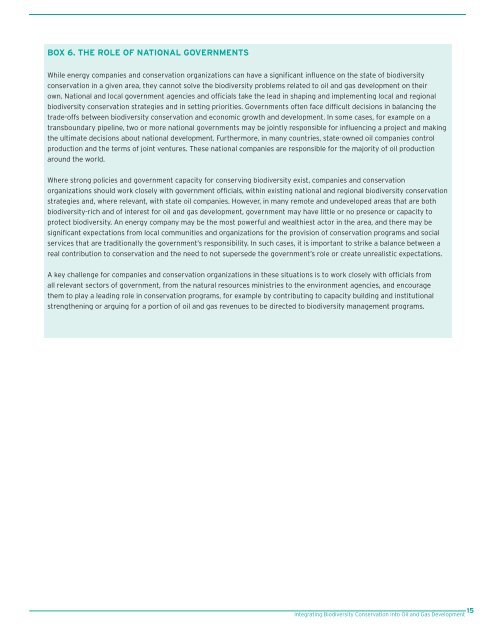Integrating Biodiversity Conservation into Oil and Gas ... - EBI
Integrating Biodiversity Conservation into Oil and Gas ... - EBI
Integrating Biodiversity Conservation into Oil and Gas ... - EBI
You also want an ePaper? Increase the reach of your titles
YUMPU automatically turns print PDFs into web optimized ePapers that Google loves.
BOX 6. THE ROLE OF NATIONAL GOVERNMENTS<br />
While energy companies <strong>and</strong> conservation organizations can have a significant influence on the state of biodiversity<br />
conservation in a given area, they cannot solve the biodiversity problems related to oil <strong>and</strong> gas development on their<br />
own. National <strong>and</strong> local government agencies <strong>and</strong> officials take the lead in shaping <strong>and</strong> implementing local <strong>and</strong> regional<br />
biodiversity conservation strategies <strong>and</strong> in setting priorities. Governments often face difficult decisions in balancing the<br />
trade-offs between biodiversity conservation <strong>and</strong> economic growth <strong>and</strong> development. In some cases, for example on a<br />
transboundary pipeline, two or more national governments may be jointly responsible for influencing a project <strong>and</strong> making<br />
the ultimate decisions about national development. Furthermore, in many countries, state-owned oil companies control<br />
production <strong>and</strong> the terms of joint ventures. These national companies are responsible for the majority of oil production<br />
around the world.<br />
Where strong policies <strong>and</strong> government capacity for conserving biodiversity exist, companies <strong>and</strong> conservation<br />
organizations should work closely with government officials, within existing national <strong>and</strong> regional biodiversity conservation<br />
strategies <strong>and</strong>, where relevant, with state oil companies. However, in many remote <strong>and</strong> undeveloped areas that are both<br />
biodiversity-rich <strong>and</strong> of interest for oil <strong>and</strong> gas development, government may have little or no presence or capacity to<br />
protect biodiversity. An energy company may be the most powerful <strong>and</strong> wealthiest actor in the area, <strong>and</strong> there may be<br />
significant expectations from local communities <strong>and</strong> organizations for the provision of conservation programs <strong>and</strong> social<br />
services that are traditionally the government’s responsibility. In such cases, it is important to strike a balance between a<br />
real contribution to conservation <strong>and</strong> the need to not supersede the government’s role or create unrealistic expectations.<br />
A key challenge for companies <strong>and</strong> conservation organizations in these situations is to work closely with officials from<br />
all relevant sectors of government, from the natural resources ministries to the environment agencies, <strong>and</strong> encourage<br />
them to play a leading role in conservation programs, for example by contributing to capacity building <strong>and</strong> institutional<br />
strengthening or arguing for a portion of oil <strong>and</strong> gas revenues to be directed to biodiversity management programs.<br />
15<br />
<strong>Integrating</strong> <strong>Biodiversity</strong> <strong>Conservation</strong> <strong>into</strong> <strong>Oil</strong> <strong>and</strong> <strong>Gas</strong> Development
















![[PDF] Community Development Toolkit - CommDev](https://img.yumpu.com/48616495/1/184x260/pdf-community-development-toolkit-commdev.jpg?quality=85)
